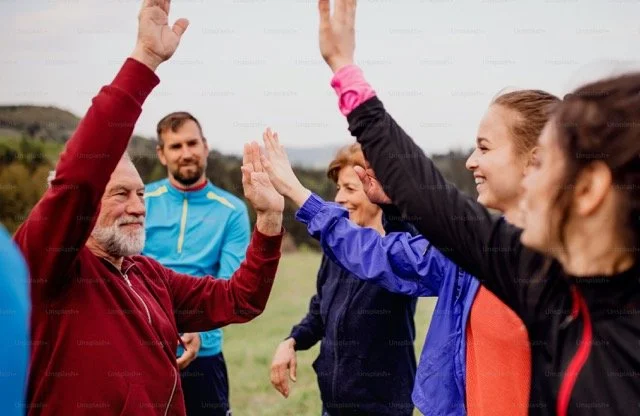How to start a healthy lifestyle - Unlocking the Pillars of Good Health: A Guide to a Balanced Life in Lehigh Valley
Fads come and go, but a foundation stands the test of time.
In the ever-changing landscape of health trends, the Pillars of Good Health have remained steadfast over time. They serve as a timeless guide to achieving a well-rounded, balanced lifestyle. Just as a table with five sturdy legs provides more stability than one with only three, the five Pillars of Good Health offer comprehensive support for your well-being. Let's delve into these pillars and explore how they contribute to creating a harmonious and fulfilling life.
“The Pillars of Good Health are your roadmap to an abundant life”
THE HEART - BEGINNINGS
At Good Health Acupuncture, we believe that all of life begins and ends in the heart. But what does this mean, exactly? Clinical psychologist Jordan Peterson aptly states, "If we are planning to base our lives on how we feel, good luck, in fact good luck knowing why you do anything you do." Our actions and behaviors are often shaped by coping mechanisms that develop in response to life's events and experiences. Long before we make conscious decisions, our hearts have decided what decisions will be considered.
What hope, then, is there for making changes? That, also, resides in the heart. In The Neurobiology of Emotional Development, Dr Allan Schore describes the cycle of joy and attachment that is necessary to make lasting changes. When we are happy to be with someone or some others, we form neurological attachments together and begin to think and act like those that bring us joy. The old adage of, “you are the average of your five closest friends” has it’s basis in this neurological truth.
Community: The Power of Connection
Community is the natural progression from the heart, for reasons described above. This pillar is crucial in understanding our own minds and how we operate our lives. In sales, there's a saying: "People like me do/buy/contribute things like this." This phrase highlights the human inclination to exist within a community. Selling to one member of a community often grants access to the entire community.
We all have our "tribe," a group with which we closely identify and willingly support. Recent research indicates that this tribe significantly shapes our character development and expression throughout life, extending beyond childhood into adulthood. However, in recent decades, our communities have diminished in size. Compared to the 1950s, 21st-century Americans gather with friends and family over 50% less frequently, and self-reported data on close relationships have declined dramatically.
This reduction in close friendships has far-reaching implications, contributing to higher rates of mental health disorders such as anxiety and depression, increased prescription medication use, rising feelings of isolation and helplessness, and elevated suicide rates. The world faces a crisis, and nurturing deeper community connections has the potential to be part of the solution..
EARTH IS AT THE CENTER OF ALL THINGS: The ancient saying, "Earth is at the center of all things," isn't meant to endorse a geocentric worldview but to offer a philosophical perspective. Ancient Asian philosophers observed the world around them, and we can gain insights by doing the same. When we examine the natural world, it becomes evident that everything ultimately connects back to the Earth.
Plants, for example, rely on the Earth's soil for stability, moisture, and nutrients, essential for growth. Healthy soil acts as a carbon repository, facilitating the transfer of carbon. Similarly, herbivores depend on the Earth to nourish the plants they consume, converting them into energy. Even carnivores indirectly rely on the Earth, as it sustains herbivores. This intricate web of life demonstrates the central role of Earth in the natural order.
Likewise, in the human body, digestion plays a pivotal role. Just as Earth is central to all processes in the natural world, digestion is central to every bodily function. Proper digestion and nutrient absorption are essential for muscle function, organ repair, and blood circulation. Without efficient digestion, our bodies cannot thrive.
MOVEMENT: THE ESSENCE OF LIFE
Speaking of circulation, movement is our next Pillar of Good Health. While the heart propels blood through the high-pressure arterial system, other fluid systems, such as the venous and lymphatic systems, rely on skeletal muscles for pumping. Unlike the heart, these systems lack their own pumps and instead use one-way valves to push fluids, depending on muscle movement.
Regular exercise has been consistently linked to numerous health benefits. Individuals who engage in consistent, progressive exercise are less susceptible to disorders like diabetes, age-related bone loss, and neurodegenerative conditions like Alzheimer's and dementia. Additionally, they tend to maintain healthier body compositions and higher energy levels throughout their lives.
Our body's muscles serve multiple functions, acting as both levers and anchors. While appendicular muscles facilitate dynamic movement, the muscles of the torso anchor and shield, providing stability to the spinal column and protecting internal organs. A common complaint we encounter is low back pain, often associated with a lack of regular exercise. We firmly believe that intelligent, lifelong movement is key to anchoring, shielding, and enabling dynamic pain-free motion.
It's worth noting that ancient physicians spoke of multiple vessels responsible for substance movement within the body. For example, the heart propels blood and qi, the san jiao moves physiological heat, and the lungs move defensive qi. Recent studies have demonstrated that breathwork can enhance immune system function, correlating with the classical concept of "defensive qi."
REST: THE CRUCIAL REPAIR PHASE
We spend 25 - 35% of our lives asleep. . If we live for 90 years, that's between 22 and 32 years spent asleep. This stark reality highlights the importance of assessing the quality of our rest and sleep.
In his book "Why We Sleep," author Matthew Walker emphasizes that sleep is when our bodies perform essential repair and recovery work. Sleep is intertwined with nearly every bodily system, influencing cognitive function, inflammation, and blood sugar regulation. Sleep deprivation elevates the risk of chronic diseases, including a 48% increase in heart disease risk and a threefold increase in type 2 diabetes risk.
Moreover, sleep quality matters just as much as quantity, if not more. A restful night's sleep involves cycling through all four stages of sleep—non-REM sleep, light sleep, deep sleep, and REM sleep—multiple times. Timing also plays a crucial role; studies suggest that the body undergoes optimal repair between 10 pm and 2 am, emphasizing the importance of early bedtime for maximum restoration.
“You will always have what your heart believes”
It really does begin and end in the heart. At Good Health Acupuncture, we witness the transformative power of acupuncture and traditional Chinese medicine daily. While many seek us out for specific health concerns, they often discover unexpected benefits in various aspects of their lives. We are in the business of changing beliefs, both about ancient medicine's capabilities and individuals' potential. As beliefs shift, a cascade of positive changes permeates every aspect of life, creating a flood of goodness that extends far beyond the individual.
To embark on this transformative journey or learn more about how Good Health Acupuncture can support your well-being, contact us today. Your path to a balanced, healthy life begins here.





